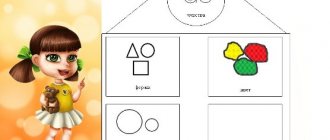Areas of work
Based on the goals and objectives, as well as the conditions and circumstances of the formation of the individual, social and communicative development is directly related to the activity side of the child’s development. For this reason, in practice, child development is carried out through the following areas of SCD (socio-communicative development in the older group):
- Game work. Play work is considered fundamental for preschoolers, that is, the tasks and problems of educational activities are realized mainly through it.
- Labor dynamism. Self-service. In early preschool age, these types of work have a sign-symbolic form; in this case, the imitation method is used, when the children repeat the actions and movements of the elder. For example, a teacher takes a pencil, draws a line on a sheet of paper - the child repeats, then the adult draws 3 more lines to make a rectangle - the child repeats again.
In the middle and senior groups, there is a shift in values towards partnership, that is, not repetition of actions, but common execution (or addition). For example, a child takes a watering can from a shelf, an adult pours water, a child waters a flower.
Didactic
In the younger group, the game “Let’s teach the bunny to speak competently” is used to develop intonation expressiveness. Its essence is that a visitor comes to class - a little bunny, who distorts phrases, for example, the names of animals (“donkey” instead of “bear”, “ot” instead of “cat”). The guys correct the bunny by speaking phrases correctly.
To teach how to compare geometric objects, use the game “Find an Object”: the children stand in a circle, the teacher throws a ball to the baby, shows an illustration of a geometric figure, the baby names it and looks for a similar object.
The team often uses the game “Who Says What,” the goal of which is to identify domestic and wild animals. Its essence lies in the fact that an adult, throwing a ball to one of the children standing in a circle, names the animal. The kid gives the ball and says how this animal “talks” (the predator growls, the dog barks, etc.).
Outdoor games
In the younger group, the emphasis is on developing the skill of jumping correctly, performing actions to the sound of the text. For example, the game “Run to Me”: the guys sit on chairs, the teacher is located at the other end of the room. To the phrase “Run everyone to me!” The children run up to the teacher, who greets them affectionately. To the phrase “Run to your place!” the guys will return to the chair.
In the middle group, the goals of outdoor games are considered to be the formation of endurance in running, climbing, and jumping. The game “Fox in the Chicken Coop” can be played both indoors and outdoors. On the benches (“in the chicken coop”) there are children (“chickens”), on the opposite edge of the room there is a fox hole, the role of which is played by a child or an adult. Chickens walk around the yard, when they hear the signal “Fox” they are obliged to run away, at this time the fox tries to detain the unwary chicken and take it into its own hole. If she succeeds, the child leaves the game.
In the senior and preparatory groups, the goal of outdoor games is considered to be the formation of endurance and skill in coherently carrying out actions as a whole team. Here is an example of an outdoor game for older preschool age - the game “Quickly Take It”: pine cones, chestnuts or other small objects are scattered on the floor around the children, but there is one less piece than the number of players. According to the signal "Quickly take it!" the guys bend down and take the object. The one who does not have enough suffers defeat. Outdoor activities can be done both in a group and on the street.
Goals
The goals of social and communicative formation in preschool educational institutions are determined by the Federal State Educational Standard and consist of:
- providing assistance to the growing generation in the assimilation of generally accepted moral and moral values;
- creating circumstances for the purpose of interaction between the child and other people, regardless of age;
- providing a basis for increasing the degree of self-sufficiency related to self-regulation, as well as purposefulness of actions;
- accumulation of mental and emotional content of the individual (formation of the ability to empathize, be sociable, sensitive);
- formation of skills for safe action in society, at home, in nature;
- fostering a respectful, respectful attitude towards family, comrades and the Fatherland.
Conditions for personality formation
The concept of “social-communicative formation” establishes conditions that have a great influence on the development of the growing personality:
- family (personal characteristics of an individual, such as character, habits, are formed by heredity and the actions of elders in the family);
- environment (the formation of character, the selection of interaction methods are also determined by the fact that the child observes the boundaries of the house);
- education (a combination of methods of influencing the individual from the family and preschool education).
Motivational Techniques
In order for the children to quickly become more active and join the work, it is necessary to select the optimal motivating methods that are included in the planning of the Federal State Educational Standard for social and communicative development in the senior group:
- Demonstration in the form of illustrations is a mandatory feature of any training. Whatever topic is discussed, pictures should be presented in sufficient quantity. Thus, when exploring the “Specialty” problem, children should see illustrations from a person’s workplace.
- Poems, riddles. This technique can be used both at the beginning of training and in the middle, if the children are a little distracted and need to be “brought back” to the topic. As a rule, riddles and poems are included before the stage of consolidating the material used.
- Games. In addition to finger games, all games without exception can serve as motivational tools.
- Verbal methods. They are especially productive if the teacher speaks or asks questions on behalf of a fantasy character.




